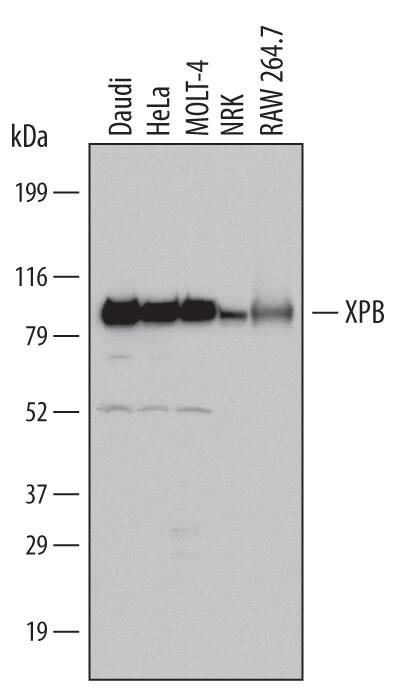Human/Mouse/Rat XPB Antibody
R&D Systems, part of Bio-Techne | Catalog # AF6349

Key Product Details
Species Reactivity
Validated:
Cited:
Applications
Validated:
Cited:
Label
Antibody Source
Product Specifications
Immunogen
Met1-Lys375
Accession # P19447
Specificity
Clonality
Host
Isotype
Scientific Data Images for Human/Mouse/Rat XPB Antibody
Detection of Human, Mouse, and Rat XPB by Western Blot.
Western blot shows lysates of Daudi human Burkitt's lymphoma cell line, HeLa human cervical epithelial carcinoma cell line, MOLT-4 human acute lymphoblastic leukemia cell line, NRK rat normal kidney cell line, and RAW 264.7 mouse monocyte/macrophage cell line. PVDF Membrane was probed with 1 µg/mL of Goat Anti-Human/Mouse/Rat XPB Antigen Affinity-purified Polyclonal Antibody (Catalog # AF6349) followed by HRP-conjugated Anti-Goat IgG Secondary Antibody (Catalog # HAF017). A specific band was detected for XPB at approximately 86 kDa (as indicated). This experiment was conducted under reducing conditions and using Immunoblot Buffer Group 1.Applications for Human/Mouse/Rat XPB Antibody
Western Blot
Sample: Daudi human Burkitt's lymphoma cell line, HeLa human cervical epithelial carcinoma cell line, MOLT‑4 human acute lymphoblastic leukemia cell line, NRK rat normal kidney cell line, and RAW 264.7 mouse monocyte/macrophage cell line
Formulation, Preparation, and Storage
Purification
Reconstitution
Formulation
Shipping
Stability & Storage
- 12 months from date of receipt, -20 to -70 °C as supplied.
- 1 month, 2 to 8 °C under sterile conditions after reconstitution.
- 6 months, -20 to -70 °C under sterile conditions after reconstitution.
Background: XPB
XPB (Xeroderma pigmentosum group B complementing protein; also ERCC3 and TFIIH 89 kDa subunit) is an 86 kDa, nuclear member of the RAD25/XPB subfamily, helicase family of proteins. It is expressed in multiple cell types, including neurons, fibroblasts and keratinocytes. XPB is part of the 10 subunit TFIIH complex. As such, it appears to participate in both nucleotide excision repair (NER) and transcription initiation from RNA polymerase II promoters. During NER, XPB utilizes an intrinsic ATPase activity to resolve nucleotide excision and repair. Human XPB is 782 amino acids (aa) in length. It contains an NLS (aa 6‑18), multiple acidic-rich regions, an ATPase region (aa 327‑488) and one helicase domain (aa 542‑702). Over aa 1‑375, human XPB shares 93% aa identity with mouse XPB.
Long Name
Alternate Names
Gene Symbol
UniProt
Additional XPB Products
Product Documents for Human/Mouse/Rat XPB Antibody
Product Specific Notices for Human/Mouse/Rat XPB Antibody
For research use only
